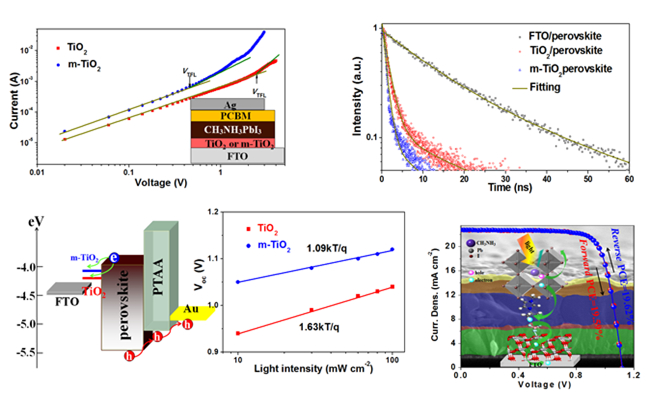
Organometal-trihalide perovskites have been recognized as the most promising absorber materials for low-cost, high efficiency solar cells. They exhibit superior properties including strong light absorption, long range charge-carrier diffusion, high carrier lifetime, and apparent tolerance to defects. The electron transport material (ETL) with excellent photoelectronic properties is very crucial in high performance of perovskite solar cells.
Recently, Silicon-based solar cell research group led by Prof. LI Can and Prof. LIU Shengzhong of Dalian National Laboratory for Clean Energy Lab prepare a planar-type perovskite solar cell with ionic liquid (IL) modification TiO2 as the ETLs. The efficiency is up to the highest value to report so far for planar-type devices. The work is an cooperation with Dr. YANG Dong of Shaanxi Normal University.

Figure. (a) Dark I–V measurement of the electron-only devices displaying VTFL kink point behaviour, with an inset showing the device structure. (b) PL decay profiles of different substrates in perovskite films (c) Illustration of energy level diagram of the PSC. (d) Representative cross-sectional SEM view the PSC device. (Image by ZHANG Doudou and YANG Dong)
DICP researchers employ the IL modification TiO2 (m-TiO2) as ETLs to fabricate the planar-type perovskite solar cells. The efficiency reaches 19.62% with hysteresis-free. It is the highest value to report so far for planar-type devices. The electron mobility of TiO2 ETL is enhanced and its Fermi level moves upward after IL modification, which is beneficial to the export of the electrons in the device. Both experimental analyses and theoretical calculations reveal that the anion group of the IL bonds to TiO2, leading to higher electron mobility and well-matched Fermi level.
Meanwhile, the cation group interfaces with adjacent perovskite grains to provide an effective channel for electron transport and a suitable setting to grow low trap-state density perovskite for improved device performance. Considering the effective surface modification, it is anticipated to be viable for large-scale roll-to-roll production.
The related results were published online in the Journal of Energy & Environmental Science (Energy Environ. Sci. DOI: 10.1039/C6EE02139E). This work has been financially supported by National Key Research Program of China, National Natural Science Foundation of China, 111-Project, Chang jiang Scholar and Chinese National 1000-Talent-Plan program.

86-10-68597521 (day)
86-10-68597289 (night)

52 Sanlihe Rd., Xicheng District,
Beijing, China (100864)

